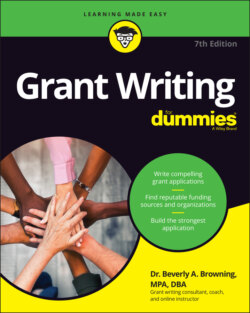Читать книгу Grant Writing For Dummies - Stan Hutton, Beverly A. Browning - Страница 26
Getting your request in the door at foundations and corporations
ОглавлениеBefore you even consider approaching a foundation or corporation with a grant request, you absolutely must research each and every potential foundation and corporate funding source. Don’t rely solely on online grant-research databases. Let your fingers do the typing to find each potential funder’s website. Read every link and become highly familiar with each source. Find out the organization’s funding priorities, the number of grants it awards annually, and the grant request range. Become very fluent in who they are, what they fund, when they fund, and their mission statement.
Whenever contract information is available, be sure to go out of your way to introduce your organization to the grantor before applying. It’s critical that you get a green light before submitting your grant application. Building a relationship before asking for a grant is the first step in this introductory process.
As a new grantseeker of a particular funder, make sure your grant request is near the low end of the grantor’s grant range. Private-sector funders don’t want to award mid- to high-funding award range amounts until after they test the waters with a small grant award. After you’ve demonstrated ethics, cost-effective grants management, and accountability to the funder, you can then ask for larger grants in future requests.
In the past, some private-sector funders have been swamped daily with large volumes of unsolicited grant proposals. To circumvent this influx of steady reading and decision making, more and more private-sector funders have moved toward requiring an initial letter of inquiry, which is a brief letter asking about the foundation’s interest in your project. If the organization is interested, it then asks you to submit a full grant proposal. If you fail to submit the letter of inquiry, you may find the door closed to your unsolicited grant proposal. I give you a link to an online letter of inquiry template at the end of Chapter 2.
Whether the private-sector funder is large or small, the attachments are a major portion of what counts with this group of grantors. The private-sector funder may ask for a copy of your organization’s IRS letter of tax-exemption, a board of directors roster, organizational and project budgets, a copy of the nonprofit’s tax return, Form-990, an organizational chart, and an audited financial statement.
Your organization’s executive director or a member of your governing board’s executive committee should build a relationship with any potential private-sector funder before you start begging for a grant. Courtesy and protocol mean everything in the private-sector funding environment, so always establish communications via email, a letter of inquiry, or a face-to-face meeting before sticking your hand out. In Chapter 22, I give you lots of tips on how to build relationships with potential funders.
If a board member at your organization happens to know a board member at the foundation or corporation you’re targeting for funding, board-member-to-board-member contact can help a ton. Foundations and corporations make decisions based on specific funding priorities, which change periodically, sometimes even annually, based on the direction that the board of directors wants to take the foundation or corporation. Although the program staff initially reviews your grant proposal and makes recommendations to the board of directors, the board has the final approval or veto. Remember, board members can override staff decisions.
